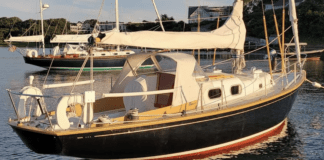
Earlier last month, I had the chance to join renowned sailing author Lin Pardey and survival expert Steve Callahan (author of Adrift: 76 Days Lost at Sea) for a round table discussion at the Port Townsend Wooden Boat Show, in Port Townsend, Washington.
Since my own approach to cruising was shaped by the philosophy of self-sufficiency that Callahan, Lin, and her husband Larry have long advocated, I wasnt surprised by their responses when discussion turned toward two categories of safety equipment weve covered extensively: the combined inflatable life jacket/harness and electronic devices used to signal distress.
Both Callahan and Pardey echoed the concerns that weve raised before. Inflatable life jackets and satellite distress communication devices like EPIRBS have impressive records, but theyre no substitute for common sense and basic skills of seamanship. The same goes for the new portable satellite communication devices (or satphones, or SEND devices like the SPOT). Our growing reliance on these backstop devices is engendering a worrisome sense of complacency. In place of a proactive approach of taking responsibility for our own safety, we adopt a more passive stance.
Sometime during the 1990s, the question, What can I do to stay on board? became What equipment can help me to stay on board? And instead of asking, What skills do I need to keep me and my crew safe at sea? new boaters asked, How can I call for help on the water? Many also assumed that simply purchasing safety equipment was enough. They didnt practice using the gear nor carry out the required maintenance.
On the topic of harnesses and tethers, Pardeys advice made perfect sense. First, learn to be comfortable aboard without the harness or tether. Being able to confidently move around your boat is critical. In this way, youll pay more attention to details like handholds and nonskid that should always take precedence over jacklines and tethers.
And although Callahans ordeal would have surely been shortened if hed had a portable VHF (nine ships passed him by), he reminded us that electronics can chip away at our environmental awareness. He wasnt saying throw away your GPS, or sever all communications, only that we need to be wary when our reliance on electronics begins to dull our senses.
This susceptibility to what I call screen creep can have unsettling results. Just as the incurable text-sender spends more time staring at his phone than interacting with the people around him, sailors intoxicated by their display screens can lose the ability to recognize natural patterns in the weather, the waves, and wind. Nurturing environmental awareness is more than just a matter of safety. To hide behind a digital wall diminishes the art of sailing into something easily quantified, which it simply isn’t. To punch a few buttons and safely sail across a pixelated sea is truly amazing, but it isn’t sailing.
What prompted this reflection was the upcoming feature in the November 2014 issue of Practical Sailor on marine single-sideband radio. During our discussion in Port Townsend, Pardey recalled a powerful storm that struck a cruising rally several years ago, and how afterward, some survivors regretted hovering over the radio instead of getting much-needed rest. They paid for the lack of sleep with poor decisions; the electronic link had become a noose.
Over time, the cruisers nets, like social media or the broadcast news, become the filter for reality. Our own ship may be fine, but hearing about the problems on other boats far away or the heeding dire predictions of armchair forecasters can rattle our nerves, raising clouds of uncertainty and insecurity. Maybe the answer to this isn’t, as some have suggested to turn the bloody thing off, but to have the confidence to recognize which channels to tune in, and which ones to ignore.








































